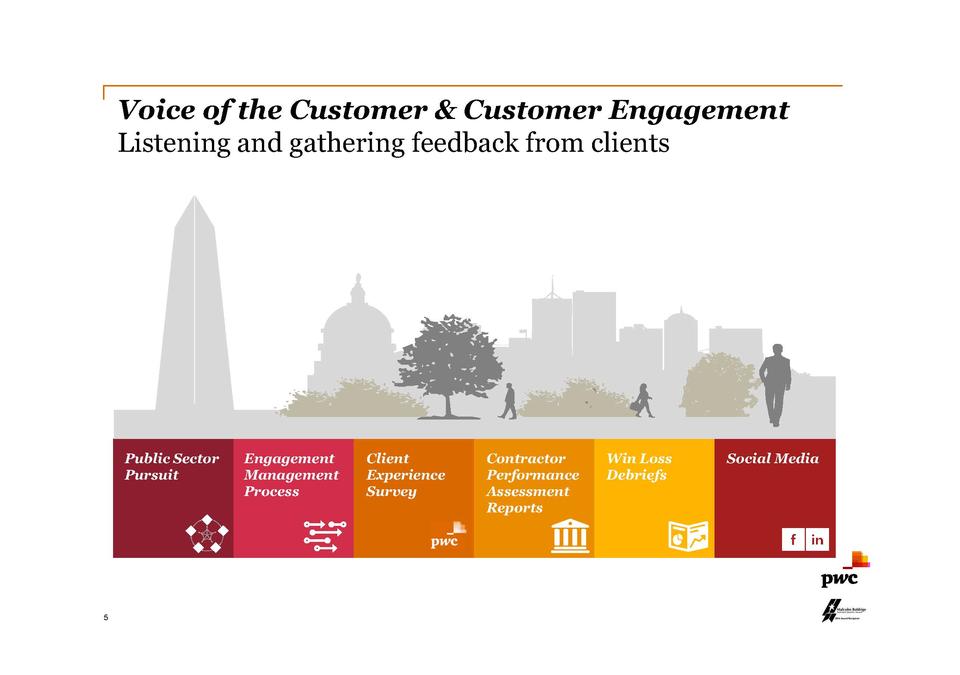Blogrige
The Official Baldrige Blog

Image used with permission.
Among challenges PricewaterhouseCoopers Public Sector Practice (PwC PSP) has faced in recent years is trying to grow within its federal market. “There is no wide space,” said Rick Rodman, a principal and quality champion for the Baldrige Award-winning organization. To address the market constraints, “We made sure we understand our client,” said Rodman.
That understanding extends to clients’ challenges, strengths, and weaknesses; the macro environment in which they operate, and their ability to undertake change, he said. To serve clients well, the professional consulting organization must ensure its industry, technical, and relationship capabilities and must customize approaches and solutions to specific client challenges. That requires cultivating a team of qualified professionals capable of delivering impact and innovation and driven by a leadership team that values client success, said Rodman.
Rodman and his colleague Karen Wilson, PwC PSP principal/customer champion, presented customer-focused practices during the Baldrige Program’s Quest for Excellence® conference last month. They shared how their organization listens to, gathers feedback from, and engages clients through six approaches: a business-development framework, an engagement management process, a client survey, contractor performance assessment reports, win/loss debriefs, and social media.
1. Pursuit
Wilson presented the organization’s Pursuit framework, which flows through five steps: Target, Interact, Propose, Close, and Exceed Expectations. “We had to tailor the firm’s (parent company PwC) process to federal clients’ environment, said Wilson, “They liked [Pursuit] so much that the whole firm is now using it.”
2. Engagement Management Process
The company’s Engagement Management Process (EMP) involves listening throughout a project lifecycle, promoting open dialogue, and soliciting actionable feedback. In a first meeting, PSP checks to ensure it knows exactly what the client wants based on the proposal. “We have to agree on the value delivered,” she said of the formal process.
3. Client Experience Survey
PSP uses surveys such as the PwC Client Experience Survey to measure client loyalty. Clients provide feedback on the organization’s performance in four areas: delivering outstanding quality, behaving ethically and complying with regulations, being attentive to clients’ and stakeholders’ needs, and providing skills and knowledgeable and responsive staff.
4. Contractor Performance Assessment Reports
The organization also uses surveys administered by its clients’ contract officers to gain feedback on its performance. Those contractor performance assessment reports evaluate the organization’s performance in six categories: Quality, Schedule, Cost Control, Business Relations, Management of Personnel, and Utilization of Small Businesses.
5. Win/Loss Debriefs
In relation to PSP’s win/loss debriefs, the organization requests a debrief from the government on both contract wins and losses. Written debriefs for individual proposals are shared with the Contracts Team, the Sales Team, and the applicable Sector Team within the organization.
6. Social Media
Beyond engaging its current clients, PSP uses social media to listen to potential customers, said Wilson.
Best Practices and Learning
Best practices Rodman and Wilson shared are to (1) integrate listening methods and sharing data on a performance dashboard for transparency across the organization, (2) continuously refine listening techniques such as social media to promote the organization’s long-term sustainability, (3) “organize investments” in client relationships such as holding regular face-to-face meetings, and (4) to conduct annual surveys.
An improvement PSP made in its survey practices as a result of feedback it received through the Baldrige Program was to broaden the base of customers it surveys in order to get more customer feedback, according to Wilson. Another improvement learned through Baldrige feedback, she said, is to share insights from debriefs more broadly within the organization.
“Was investing resources in the Baldrige improvement process worth the effort?” Rodman was asked during the Quest conference. “Absolutely,” he responded. Clients see the organization as more focused, and it is more competitive in its market as a result, he said.





